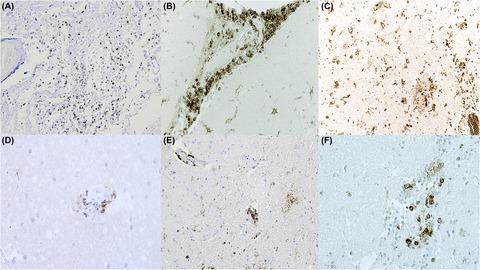当前位置:
X-MOL 学术
›
Brain Pathol.
›
论文详情
Our official English website, www.x-mol.net, welcomes your
feedback! (Note: you will need to create a separate account there.)
SARS-CoV-2 and the brain: A review of the current knowledge on neuropathology in COVID-19
Brain Pathology ( IF 5.8 ) Pub Date : 2021-08-13 , DOI: 10.1111/bpa.13013 Aniello Maiese 1 , Alice Chiara Manetti 1 , Chiara Bosetti 1 , Fabio Del Duca 2 , Raffaele La Russa 3 , Paola Frati 2 , Marco Di Paolo 1 , Emanuela Turillazzi 1 , Vittorio Fineschi 2
Brain Pathology ( IF 5.8 ) Pub Date : 2021-08-13 , DOI: 10.1111/bpa.13013 Aniello Maiese 1 , Alice Chiara Manetti 1 , Chiara Bosetti 1 , Fabio Del Duca 2 , Raffaele La Russa 3 , Paola Frati 2 , Marco Di Paolo 1 , Emanuela Turillazzi 1 , Vittorio Fineschi 2
Affiliation

|
SARS-CoV-2 (severe acute respiratory syndrome coronavirus 2), the new coronavirus responsible for the pandemic disease in the last year, is able to affect the central nervous system (CNS). Compared with its well-known pulmonary tropism and respiratory complications, little has been studied about SARS-CoV-2 neurotropism and pathogenesis of its neurological manifestations, but also about postmortem histopathological findings in the CNS of patients who died from COVID-19 (coronavirus disease 2019). We present a systematic review, carried out according to the Preferred Reporting Items for Systematic Review standards, of the neuropathological features of COVID-19. We found 21 scientific papers, the majority of which refer to postmortem examinations; the total amount of cases is 197. Hypoxic changes are the most frequently reported alteration of brain tissue, followed by ischemic and hemorrhagic lesions and reactive astrogliosis and microgliosis. These findings do not seem to be specific to SARS-CoV-2 infection, they are more likely because of systemic inflammation and coagulopathy caused by COVID-19. More studies are needed to confirm this hypothesis and to detect other possible alterations of neural tissue. Brain examination of patients dead from COVID-19 should be included in a protocol of standardized criteria to perform autopsies on these subjects.
中文翻译:

SARS-CoV-2 和大脑:对 COVID-19 中神经病理学当前知识的回顾
SARS-CoV-2(严重急性呼吸综合征冠状病毒 2)是导致去年大流行病的新型冠状病毒,能够影响中枢神经系统(CNS)。与其众所周知的肺嗜性和呼吸道并发症相比,关于 SARS-CoV-2 的嗜神经性及其神经系统表现的发病机制的研究很少,而且关于死于 COVID-19(冠状病毒病)患者的中枢神经系统的死后组织病理学发现也鲜有研究。 2019)。我们根据系统评价标准的首选报告项目对 COVID-19 的神经病理学特征进行了系统评价。我们找到了 21 篇科学论文,其中大部分是尸检;案件总数为197件。缺氧性改变是最常见的脑组织改变,其次是缺血性和出血性病变以及反应性星形胶质细胞增生和小胶质细胞增生。这些发现似乎并非特定于 SARS-CoV-2 感染,它们更有可能是由于 COVID-19 引起的全身炎症和凝血病。需要更多的研究来证实这一假设并检测神经组织的其他可能改变。应将死于 COVID-19 的患者的脑部检查纳入标准化标准方案,以便对这些受试者进行尸检。需要更多的研究来证实这一假设并检测神经组织的其他可能改变。应将死于 COVID-19 的患者的脑部检查纳入标准化标准方案,以便对这些受试者进行尸检。需要更多的研究来证实这一假设并检测神经组织的其他可能改变。应将死于 COVID-19 的患者的脑部检查纳入标准化标准方案,以便对这些受试者进行尸检。
更新日期:2021-08-13
中文翻译:

SARS-CoV-2 和大脑:对 COVID-19 中神经病理学当前知识的回顾
SARS-CoV-2(严重急性呼吸综合征冠状病毒 2)是导致去年大流行病的新型冠状病毒,能够影响中枢神经系统(CNS)。与其众所周知的肺嗜性和呼吸道并发症相比,关于 SARS-CoV-2 的嗜神经性及其神经系统表现的发病机制的研究很少,而且关于死于 COVID-19(冠状病毒病)患者的中枢神经系统的死后组织病理学发现也鲜有研究。 2019)。我们根据系统评价标准的首选报告项目对 COVID-19 的神经病理学特征进行了系统评价。我们找到了 21 篇科学论文,其中大部分是尸检;案件总数为197件。缺氧性改变是最常见的脑组织改变,其次是缺血性和出血性病变以及反应性星形胶质细胞增生和小胶质细胞增生。这些发现似乎并非特定于 SARS-CoV-2 感染,它们更有可能是由于 COVID-19 引起的全身炎症和凝血病。需要更多的研究来证实这一假设并检测神经组织的其他可能改变。应将死于 COVID-19 的患者的脑部检查纳入标准化标准方案,以便对这些受试者进行尸检。需要更多的研究来证实这一假设并检测神经组织的其他可能改变。应将死于 COVID-19 的患者的脑部检查纳入标准化标准方案,以便对这些受试者进行尸检。需要更多的研究来证实这一假设并检测神经组织的其他可能改变。应将死于 COVID-19 的患者的脑部检查纳入标准化标准方案,以便对这些受试者进行尸检。











































 京公网安备 11010802027423号
京公网安备 11010802027423号